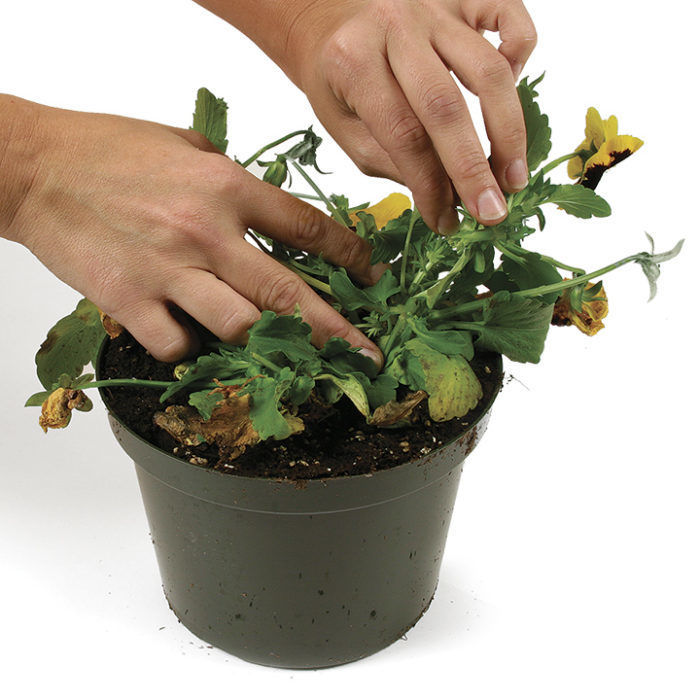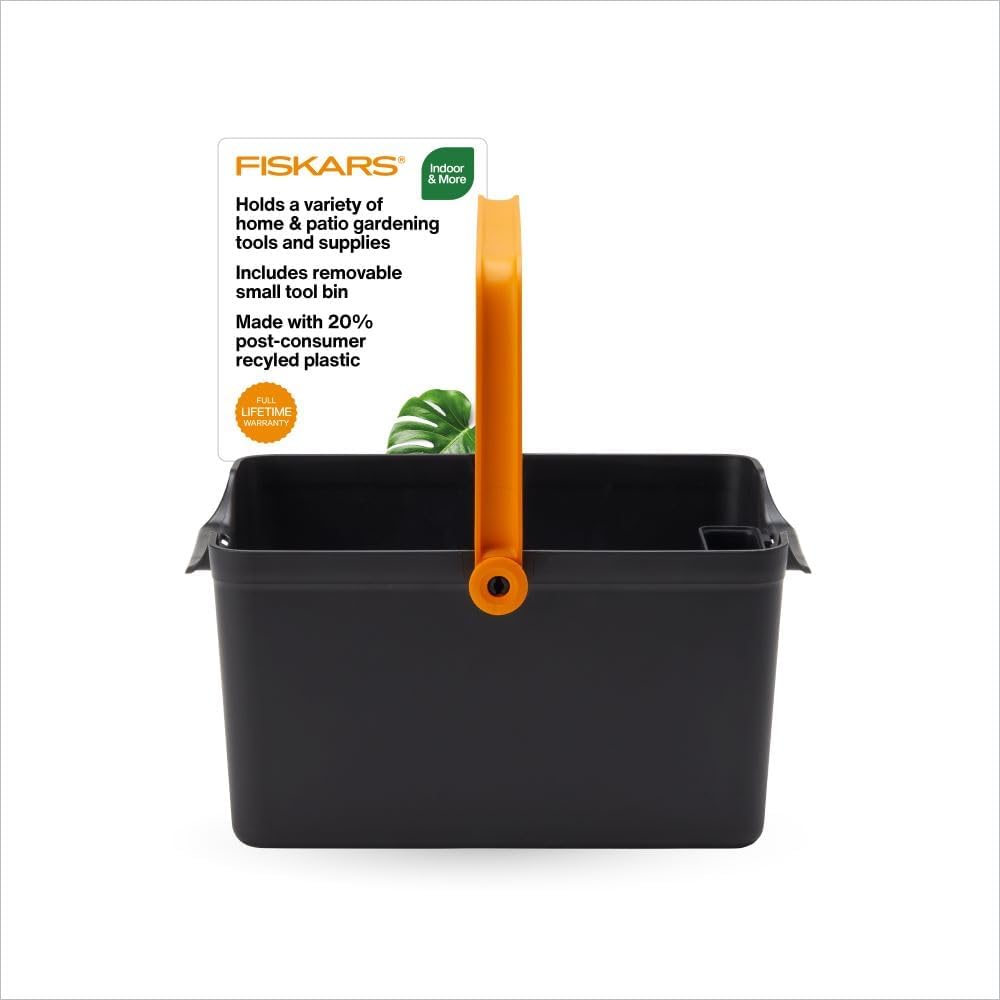Take a Fresh Approach to Pansies
Finding the right companions is the key to keeping these springtime containers looking good—even into summer

Pansies and poinsettias have a lot in common. Most people (gardeners included) view them as disposable plants—enjoyed for a few short weeks and then tossed aside. Although everyone is excited to see these spring gems in the nursery, they are usually thrown into pots haphazardly while we wait for summer annuals to be big enough to take their place. The key to creating spectacular pansy designs—which you won’t want to rip out in a few short weeks—is selecting the right companions. Although you may think that there aren’t a lot of plants that can take the unpredictable weather of early spring, there are. These six designs allow the pansies to take center stage but give them the support they need to shine for the long haul.
Perennials add bulk without overcrowding
Shrubs are great for adding some much-needed volume to a container of pansies, but they need a lot of space. If your pot is medium size, spring perennials can be a better option. There is generally a large selection of early-blooming options at the nursery around the same time that the pansies arrive. These large plants give the smaller pansies the bulk that they need without overcrowding them. Select variegated perennials or those with interesting foliage so that, even when the pansies go out of bloom, the pot will still have a varied composition.
- ‘Velour Blue Bronze’ pansy (Viola ‘Velour Blue Bronze’, annual)
- Panola™ Lilac Shade pansy (Viola × wittrockiana Panola™ Lilac Shade, annual)
- Golden Alexanders (Zizia aurea, Zones 4–8)
- ‘Daphnis’ masterwort (Peucedanum ostruthium ‘Daphnis’, Zones 5–9)
- ‘Purple Leaf’ corydalis (Corydalis flexuosa ‘Purple Leaf’, Zones 6–8)
- English ivy (Hedera helix cv., Zones 5–11)
Spring greens are an easy way to add bold texture
Whoever said that the companion options for pansies in early spring are limited must never have browsed the vegetable tables at the nursery. A huge variety of spring greens will tolerate cold temperatures, while adding unique textures. Lettuces, like ‘Red Sails’ and ‘Buttercrunch’, are particularly eye-catching because of their puckered leaves. Remember this, though: The bolder the foliage texture, the larger the pansy blossoms should be to keep the focus balanced between the pansies and their friends. When the lettuces are ready to harvest, the pansies are generally ready to be replaced too.
- ‘Penny Orange’ pansy (Viola ‘Penny Orange’, annual)
- Delta™ Pure Deep Orange pansy (Viola × wittrockiana Delta™ Pure Deep Orange, annual)
- ‘Red Sails’ lettuce (Lactuca sativa ‘Red Sails’, annual)
- ‘Buttercrunch’ lettuce (Lactuca sativa ‘Buttercrunch’, annual)
- Parsley (Petroselinum crispum, Zones 5–9)
- Chives (Allium schoenoprasum, Zones 5–11)
- Rosemary (Rosmarinus officinalis, Zones 8–11)
- English ivy (Hedera helix cv., Zones 5–11)
Evergreens provide the best backdrop
Pansies are full of vibrant, bold color, but let’s face it: They are small. Every well-composed mixed container needs a thriller, but this can be a hard item to find in early spring. It’s too early for tropicals, and it will still be months before any sizable annuals are safe to plant outside. Fortunately, you can take advantage of an evergreen you may already have in a pot. The relationship between a pansy and an evergreen is mutually beneficial. The pansy spices up an evergreen, and in turn, an evergreen shrub adds size to the arrangement. This pot even takes advantage of an ever-“green” black mondo grass.
- ‘Elegantissima’ variegated boxwood (Buxus sempervirens ‘Elegantissima’, Zones 6–8)
- ‘Gold Cone’ juniper (Juniperus communis ‘Gold Cone’, Zones 2–6)
- ‘Nana Gracilis’ dwarf hinoki cypress (Chamaecyparis obtusa ‘Nana Gracilis’, Zones 4–8)
- Black mondo grass (Ophiopogon planiscapus ‘Nigrescens’, Zones 6–11)
- Sorbet™ Black Duet violet (Viola cornuta Sorbet™ Black Duet, Zones 6–9)
Cold-hardy annuals are showy and inexpensive
Although pansy-centered pots are beautiful, the money-conscious gardener might still find it tough to spend the cash on shrubs and perennials for these spring containers. For folks who like to pinch their pennies, why not plant a variety of inexpensive, cold-hardy annuals and a perennial pansylike violet instead? In this combination, I chose ‘Purple Showers’ horned violet and then selected annuals with a similar plum hue, like nemesia. Although subtle, even the bluish violet hue in the center of the osteospermum provides a noticeable color echo.
- ‘Purple Showers’ horned violet (Viola cornuta ‘Purple Showers’, Zones 6–8)
- Soprano® White osteospermum (Osteospermum ‘Osjamwhit’, annual)
- ‘Aromatica Royal Blue’ nemesia (Nemesia fruticans ‘Aromatica Royal Blue’, annual)
- ‘Emerald Lace’ plectranthus (Plectranthus oertendahlii ‘Emerald Lace’, Zone 11)
A great way to complement pansies with small blooms is by pairing them with an array of plants with fine texture. Herbs, like the wispy bronze fennel and delicate-leaved golden lemon thyme, offer a wide textural range and can be snuggled into a relatively small container. (This bathtub pot is actually only 1 foot long). Dark burgundy flowers, like those of this horned violet, need lighter-hued companions to stand out, so herbs with silver and light green leaves are ideal pot partners.
- Sorbet™ Antique Shades Improved horned violet (Viola cornuta Sorbet™ Antique Shades Improved, Zones 6–9)
- Parsley (Petroselinum crispum, Zones 5–9)
- Bronze fennel (Foeniculum vulgare ‘Purpureum’, Zones 4–9)
- Chives (Allium schoenoprasum, Zones 5–11)
- ‘Tricolor’ sage (Salvia officinalis ‘Tricolor’, Zones 7–8)
- Golden sage (Salvia officinalis ‘Aurea’, Zones 5–8)
- Golden lemon thyme (Thymus citriodorus ‘Aureus’, Zones 6–9)
- Chocolate mint (Mentha piperita f. citrata ‘Chocolate’, Zones 3–7)
- English lavender (Lavandula angustifolia, Zones 5–8)
- Curly-leaf parsley (Petroselinum crispum ‘Crispum’, Zones 5–9)
Once you realize pansy companions can include shrubs and perennials, it can be easy to get overwhelmed with the choices. To make a successful combination, you can’t simply throw a few quart-size perennials and a 1-gallon shrub into a vessel and assume that they will make your pansies look better than you ever imagined. To narrow things down, choose one perennial that contrasts with your pansy of choice. Then select companions with a similar color as your top-pick perennial. In this container, I started with ‘Persian Chocolate’ moneywort, then chose three other hardy plants that matched either the foliage or flower color of the moneywort. The similarly colored plants blur together, allowing the pansy to pop.
- Coppertina™ ninebark (Physocarpus opulifolious ‘Mindia’, Zones 3–8)
- Bowles’ golden sedge (Carex elata ‘Aurea’, Zones 5–9)
- Golden creeping Jenny (Lysimachia nummularia ‘Aurea’, Zones 4–8)
- ‘Ultima Morpho’ pansy (Viola × wittrockiana ‘Ultima Morpho’, annual)
- ‘Persian Chocolate’ moneywort (Lysimachia congestiflora ‘Persian Chocolate’, Zones 6–9)
What’s the difference?
Gardeners often use the common names pansy, Johnny-jump-up, and violet interchangeably, but they are actually different plants.
 |
 |
 |
Pansy
This term generally refers to any of the cultivars belonging to Viola × wittrockiana (annual) or any other annual members of the genus Viola. Contrary to popular belief, pansies have blossoms of all shapes and sizes; they are not just those that have blooms bigger than a quarter.
Johnny-jump-up
Although most folks use this term for any small-flowered Viola, it is actually the common name for only V. tricolor (annual). Most notably, these plants come only in shades of purple, white, and yellow.
Violet
All of the plants in the Viola genus are technically violets, but this common name is generally reserved for those species that are considered evergreen or semievergreen perennials, like horned violet (V. cornuta, Zones 6–9, pictured).
Help your pansies go the distance
There is no getting around the fact that pansies like cool temperatures. This generally means that the minute the weather turns a bit warmer, your pansies start looking spent. Here’s how to get a little more out of your pansies this year.
Give them a little pinch

When pansies start to stretch and get leggy, you should immediately cut the stems back a few inches. This will help the plant bush out more. Also, be diligent about cutting off any dead blooms or yellowed leaves.
Don’t overfertilize
Pansies tend to do best when given a slow-release, granular fertilizer at planting time—and then never feed them again. Applying a regular dose of liquid fertilizer (or, worse yet, a blossom-boosting formula) pushes them to mature too quickly, causing them to go to seed faster than they would if left alone.
Provide a bit of shade
A pansy grown in full sun is always going to peak earlier than one grown in partial shade. Slow down the aging process by making sure your containers are in a spot that doesn’t get more than six hours of sun per day.

Relocate them during their awkward phase
Much like teenagers, pansies go through an ugly period (usually when temperatures rise above 80°F). At this point, you can pull them out, toss them in the compost pile, and find a replacement for your pots. Or you can pull them out, cut back the entire plant to 1 to 2 inches tall, and relocate it to a partially shaded spot. This will allow the pansies to regroup and bounce back just in time to fill in some blank areas in your fall containers.
Sarah Partyka owns The Farmer’s Daughter, a nursery in South Kingstown, Rhode Island.
Photos, except where noted: Danielle Sherry
Fine Gardening Recommended Products

Fiskars Garden Tool Caddy with Removable Small Tool Storage for Indoor and Outdoor Gardening Use, Made with Recycled Plastic
Fine Gardening receives a commission for items purchased through links on this site, including Amazon Associates and other affiliate advertising programs.

Corona® Multi-Purpose Metal Mini Garden Shovel
Fine Gardening receives a commission for items purchased through links on this site, including Amazon Associates and other affiliate advertising programs.













Comments
Thank you. You helped me solve where to put my extra lettuce - with my pansies!
Log in or create an account to post a comment.
Sign up Log in